
Vol. 1, No. 7 NEWS PUBLICATION OF THE XX BOMBER COMMAND 13 APRIL 1945

|
Only 84 Forts Lost in Combat
Although the B-29 Superfortress has been definitely proven as a successful combat machine, its missions are still in the initial stage.
Brig. Gen. Lauris Norstad, Chief-of-Staff of the Twentieth Air Force, made a recapitulation of results achieved by units of this Air Force in a recent press conference at Washington.
Recently the rate of B-29 operations has been stepped up sharply but the losses have dropped just as sharply. This being true plans for future operations of the two Bomber Commands can be increased substantially. The B-29 can now be employed with as great or greater operational efficiency than the Air Forces employ the B-17 and B-24.
Gen. Norstad announced that aircraft losses for the Twentieth total 170 aircraft - these include 84 combat and 86 operational. Two factors are expected to cut this figure in future operations. B-29s are no longer employed for "over the Hump" ferrying missions and the island of Iwo Jima provides an emergency landing field to rescue crippled bombers.
Gen. H. H. Arnold has asserted that within six months, operations against Japan may be trebled. he states that 1000 plane raids may be possible before the end of the summer.
While Washington officials hinted at the future, the B-29s continued striking at the Japanese empire. The XX Bomber Command carried bombs to Rangoon and to Bukum Island off Singapore. This island is a large oil storage dump. The XXI Bomber Command flew operations against Omura, Nagoya and Tokyo. Two new targets for the XXI were hit. They are supply depots located at Oita and Tachiari, Japan.
Allies Head For Japan Mainland
Japan looms directly ahead - over a sea lane speckled with island obstacles.
How much time will be required to clear the Jap-infested islands, if they are to be, is a matter of speculation. War analysts don't agree. But, one thing is almost certain: Japan proper will be invaded.
In a recent statement prepared for radio broadcast, Maj. Gen. Claire L. Chennault of the Fourteenth Air Force could foresee no way in which Japanese might prevent Allied landings on the home island of Japan.
He said: "I think I can say now that we enjoy superiority over all of occupied China. The Japanese are now attempting to dig themselves in for the last stand in China, Manchuria and Korea, as well as on their own islands.
"I can see no way they can avoid Allied landings in Japan."
Lt. Gen. Albert C. Wedemeyer, Commander of American forces in the China Theater, said: "I cannot do yet what I would like to do against the Japanese, but I am hopeful."
Hinting on what is to come in the way of Superfortress raids, the "softening up process," Gen. Henry H. Arnold remarked: "If the Japs are unhappy now, they will soon be two or three times as unhappy."
Gen. Douglas MacArthur and Admiral Chester Nimitz are carrying out their "On to Tokyo" campaign, smashing the "stepping-stone" islands enroute.
Their latest strike was in the enemy's home waters - in the Ryukus chain. Employing the largest amphibious operation of the pacific war to date, the U.S. 10th Army invaded the west coast of the island of Okinawa. More than 1400 ships were used. A Royal Navy task force supported the landings by bombing and shelling. Strategic support was given by shore-based air forces from the Southwest pacific areas and by the XXI Bomber Command.

|
While the capture of Iwo Jima island gave the Americans an airbase only 660 miles from Tokyo, the capture of Okinawa will provide bases only 325 miles from Japan. Described as an invaluable springboard for the last leap to the Japanese mainland, Okinawa's occupation would bring American air forces within fighter range of the enemy's homeland.
The Japs have between 60,000 and 80,000 defending the island.
The Ryukyu chain, lying in the 775-mile arc between Formosa and Kyushu, is of great strategic value to Japan as bases guarding the southern approaches to the enemy's mainland. It separates the East China Sea from the Pacific Ocean and forms a string of fortresses guarding the China coast from Foochow to Korea.
carrier-based bombers of the U.S. Pacific Fleet first attacked shipping and shore installations in the Ryukyus on Oct. 8, 1944, and made frequent attacks right up to the invasion landing.
Referred to by the Japs as their "stepping stones to Formosa," the Ryukyus is composed of some 140 islands an islets, with a total area of 1,850 square miles. The southernmost island is 73 miles east of Formosa, while the northernmost island of the archipelago is 80 miles south of Kyushu.
Okinawa Jima is the largest of the islands, 485 square miles in area.
Governed by the Japs since 1609, the Ryukyus is now considered, politically, as an integral part of Japan. The terrain of the northern group of islands is broken with sharp highlands and precipitous hills. The Okinawa group, centrally located, has rolling hills. The southern group is flat. The two beat harbors in the chain are Nawa and Shuri, both on Okinawa Jima.
Agriculture is the principal industry and sugar is the main cash crop. The bulk of the islands' external trade is with Japan, and Ryukyu-grown sugar and sweet potatoes are an important source of Japan's food supply of these products.
A considerable number of minerals are found in the Ryukyus, but only phosphate and coal deposits are of sufficiently good quality to be important commercially.
|
B-29s Wipe Out Large Tokyo Area
During his Washington press conference, Brig. Gen. Lauris Norstad, Chief of Staff, Twentieth Air Force disclosed the extent of damage wrought by the XXI Bomber Command's incendiary attack on Tokyo.
He said: "In Tokyo alone, over 20 percent of her total industrial production has been wiped out for at least three months, and over five percent of it for a full year. It is estimated that 1,200,000 factory workers were made homeless by the destruction of 200,000 to 250,000 buildings. Some 3,000 plants and shops were destroyed, 369 MILLION square feet of highly-industrialized land were leveled to ashes. Of the large factories in the area, 45 were completely destroyed, 26 were extensively damaged, 30 more moderately damaged, and 16 others damaged to some extent.
"In addition, public utilities were disrupted, the telephone exchange destroyed, a principal food storage and distributing center wrecked. Important transportation facilities such as freight yards, street car barns and a railroad station were destroyed. Three gas plants were substantially damaged. The disruption to civil services and public utilities will cause absenteeism from war factories of at least 100,000 man-months, without counting the enormous direct loss of man-months of work due to destruction of factories.
"We do not yet have the appraised reports on our other four incendiary attacks this month (March). But the destruction in Nagoya, Osaka and Kobe is similar to that in Tokyo in comparison with their size, and we confidently expect the final appraisals to show a proportionate degree of disruption to the Japanese industrial machine."
In closing that portion of his report Gen. Norstad stated, "It is very doubtful that such a high cost has previously been inflicted upon any people in a single eight day period."
|
HEADQUARTERS, XX BOMBER COMMAND, INDIA - Just glance into the skies!
If there's a U.S. Army plane in sight, that should serve as your initial introduction to Col. Charles K. Moore, Deputy Chief-of-Staff; for he is literally a part of the fighters and bombers that are "softening up" the enemy for the final thrust.
Col. Moore established the design criteria for such pursuit fighters as the Lightning, Thunderbolt and Mustang, and bombers as the Fortress, Liberator, and Superfortress. It also was his job, as one of the two Army members of the Structural Committee, National Advisory Committee for Aeronautics, to thoroughly structurally test each airplane to determine its overall strength factors.
During the period 1937 to 1942, he served in the Aircraft Laboratory at Wright Field, the first experimental pressure cabin airplane (Lockheed XC-35) was completed and tested establishing the preliminary requirements leading to the present B-29 pressure cabin design.
Col. Moore has been in the Army since 1928, having been appointed a Flying Cadet soon after he was graduated from the University of Illinois as a Civil Engineer. He was commissioned a 2nd Lieutenant, Air Corps, Regular Army, in October of 1929.
Ensuing assignments found him serving as a Squadron Engineering officer, Supply and Assistant Depot Engineering officer. In 1935, he was a student in the Air Corps Engineering School, two years later was graduated from the California Institute of Technology with a Masters degree in Aeronautical Engineering.
Before being assigned as one of the six original members of Maj. Gen. K. B. Wolfe's staff to initiate the Special Wolfe Project to develop the B-29 and commit it to combat, he served as Technical Executive on the staff of the Commanding General at Wright Field.
Col. Moore was Aeronautical Engineer on the Special Technical Staff of the Wolfe Project, which was responsible for the initial flight testing of the Superfortress, all modifications required to make the airplane and engine acceptable for combat, the development of the Central Fire Control System and the obtaining of necessary supplies and equipment to enable the XX Bomber Command to function overseas.
Under Brig. Gen. L. G. Saunders, he was Chief-of-Staff of Headquarters, Rear Echelon, XX Bomber Command. Overseas since April of 1944, the Colonel served as Acting Chief, A-4 and Assistant A-4, later as Commanding Officer of the Command's Air Transport Group.
His present assignment is that of Deputy Chief-of-Staff, Maintenance and Supply.
Col. Moore is a member of the following professional societies and fraternal organization: The Institute of Aeronautical Sciences, Triangle, Sigma XI, Chi Epsilon, Sigma Tau, Icarus, and Scabbard and Blade.
His wife, Judith Lee, and their three sons, Kenneth hart, Donald Leigh, and Michael Lee, are now residing in San Antonio, Tex., for the duration.
|
Gunfire Rips Charts From Lt's Hands
APO 220 (Piardoba) - Some day after the war is over, Lt. Harold Vicory, 23-year-old Kansan, may dig a package of torn maps from his Army foot locker and spin the tale of his luck over Singapore. It's a sure bet his audience will be attentive, for the story will be of an unbelievable war peculiararity - the type that Robert Ripley specializes in.
The Superfortress "694," a new B-29, was on its first mission, winging its way toward the target on a recent Singapore raid.
"Enemy fire was very thick," said lt. Vicory, a radioman. The Japs were really peppering us.
"I was working at my desk (with a packet of maps and charts) when gunfire pierced the belly of the plane. It zipped between my legs, up through the top of the desk, through the maps and shot out the top of the plane. It all happened pretty fast."
After he had collected his wits, Lt. Vicory examined his maps to discover that part had disappeared into thin air.
"Then to top it all off," the lieutenant laughed, "the navigator calls back and wants me to give him some information. Hell, I couldn't piece those maps
 together if I'd wanted to."
together if I'd wanted to."
Ground examination of the Superfortress revealed that it had 17 holes.
|
Two GIs Devise Power Driven Hack-Saw
A XX BOMBER COMMAND BASE, INDIA - The XX Bomber Command's Air Depot is a highly mechanized organization, supporting B-29 operations against Japan. However, conversion from man power to machine power, in simpler aspects, is largely brought about by individual ingenuity. A sample of this ingenuity is the power driven hack-saw devised by two GIs of the Ordnance section of the Depot.
Sgt. Charles R. Dare and Cpl. Alfred V. Kubici found that the man power and time necessary to saw metal by hand was cutting into their schedules, and in some instances holding up their projects. Working in their spare time, they assembled the machine and geared the motor so that the cutting blade made from 40 to 45 cuts per minute. The whole contraption, scrap-metal base and stand, second-hand electric motor and gears from a discarded hoisting device weighs approximately 500 pounds - cost about $35. Similar factory- made machines range in cost from $400 to $1500.
The saw has substantially increased the efficiency of the section. Where a whole day was consumed previously in hand-sawing a brass bar of 3-inch diameter, for example, only 25 minutes is necessary with the use
 of the new machine. The cut edge of a hand-sawed piece of material formerly required additional machining to smooth it, thus wasting valuable metal and time. With the power driven saw a smooth, straight cut is made, and even the filings are salvaged for further use.
of the new machine. The cut edge of a hand-sawed piece of material formerly required additional machining to smooth it, thus wasting valuable metal and time. With the power driven saw a smooth, straight cut is made, and even the filings are salvaged for further use.
Plans for modifying the present machine have already been discussed by the two men to increase its efficiency and safeguard against accidents.

|
|
HEADQUARTERS, XX BOMBER COMMAND, INDIA - Lt. Jack T. Hull, B-29 bombardier who stuck to his post and accomplished his mission after his left eye had been knocked out as a result of enemy fire, has been presented the Distinguished Service Cross for "extraordinary heroism and meritorious service."
Brig. Gen. Roger M. Ramey, Commanding General of the VV Bomber Command, made the presentation in his office just before Lt. Hull departed by air for the United States for treatment.
Hull was flying his fourth mission, an attack upon the Singapore Naval Base recently, when Japanese fire struck his Superfortress "Pioneer III" as it started its bombing run. The fire shattered a section of the bombardier's radio equipment, and a flying fragment of the radio destroyed Lt. Hull's eye. Other pieces lodged in his right hand and arm.
The citation read:
"Recovering from his first shock, 2nd Lt. Hull realized that he must drop his bombs with the formation leader. Donning his oxygen mask, he turned toward the lead aircraft and at the proper time, salvoed his bombs on the leader. He then closed the bomb bay doors and closed the rack switches. Knowing that the airplane was still in a danger area and not wishing to excite the crew, he stayed in his position and did not turn around until his formation had turned off the bombing run. He then turned around and asked for aid from the other crew members, this being the first time at which they learned that he had been seriously wounded."
 New swimming pool at XX Bomber Command's Air Depot isn't exclusively for recreation activities.
It's also used as a training pool for combat crews. Since the Superfortresses of this Command must span large bodies
of water to bomb Japanese targets, knowing how to properly inflate a life raft is like having an insurance policy
on living. And, nothing can take the place of practical experience - just in case of an accident. This combat crew
member, also protected with the "Mae West" that all B-29 men must wear, demonstrates the proper way to inflate a raft.
It doesn't appear like much, but the raft "gives a real feeling of security" when there is nothing but water in sight.
New swimming pool at XX Bomber Command's Air Depot isn't exclusively for recreation activities.
It's also used as a training pool for combat crews. Since the Superfortresses of this Command must span large bodies
of water to bomb Japanese targets, knowing how to properly inflate a life raft is like having an insurance policy
on living. And, nothing can take the place of practical experience - just in case of an accident. This combat crew
member, also protected with the "Mae West" that all B-29 men must wear, demonstrates the proper way to inflate a raft.
It doesn't appear like much, but the raft "gives a real feeling of security" when there is nothing but water in sight.
|
Making its debut over station VU2ZU, Calcutta, last Sunday, the radio program "Spell and Speil" will continue for nine consecutive weeks, announced Capt. Donald B. Bischoff, Command Information-Education Officer.
Presented by the I-E section, Headquarters Army Air Forces for the I-B Theater, the program will publicize the facilities of USAFI - although it is primarily of entertainment calibre. First prize each week to the contestant who score the most points

|
Interested personnel of the XX Bomber Command may obtain additional information by contacting their respective Information-Education Officer.
The Enlisted Man's Gal
American girls are few and far between in India, but in the XX Bomber Command the Enlisted Man has one gal he can always count on - She of the ARC. These sociable girls are doing a real job; they're keeping the men occupied during their off-duty hours. To break down their assignment would require pages of copy, for they do everything from serving "coffee and doughnuts" to returning combat crews to supervising photo tours of India. These photos depict a few of their everyday recreational activities.
 In the left picture, the ARC girls make preparations for an Easter party.
They are, left to right, Mary Thomas Schiek, Fay Fetterolf and Nettie Lusk. A game of bridge (right) finds hostesses
Helen Meany and Kay Riley entertaining Cpl. Paul Van Bebber, left, and Sgt. Frederic J. Wood.
In the left picture, the ARC girls make preparations for an Easter party.
They are, left to right, Mary Thomas Schiek, Fay Fetterolf and Nettie Lusk. A game of bridge (right) finds hostesses
Helen Meany and Kay Riley entertaining Cpl. Paul Van Bebber, left, and Sgt. Frederic J. Wood.
 Shooting the breeze over a coke is a favorite pastime (left). From left to right, finds T/3
Henry Weaver,
T/5 Harry Boodgood, T/5 Ralph Hughey, Jr., Midge Riley and T/5 Milton Caverly engaged in a lively gabfest.
Ina Belle Stoke plays the piano for a group of Bomb Bay crooners (right).
Shooting the breeze over a coke is a favorite pastime (left). From left to right, finds T/3
Henry Weaver,
T/5 Harry Boodgood, T/5 Ralph Hughey, Jr., Midge Riley and T/5 Milton Caverly engaged in a lively gabfest.
Ina Belle Stoke plays the piano for a group of Bomb Bay crooners (right).
|
APO 220 (Piardoba) - From Northern Maine to Southern California, from Washington to Florida . . . nearly everywhere within the United States . . . youngsters interested in the Hellbird group are proudly displaying their membership cards and Fledgling patches.
More than 300 youngsters are now members of the Hellbird Fledglings, according to Maj. J. R. Fawcett, who has charge of the newly-founded organization.
When a member of the Hellbirds turns in a name to Maj. Fawcett, the youngster is sent a patch which bears a replica of the insignia appearing on all B-29s of that group. He also receives a mimeographed sheet acquainting him with the following facts about the Hellbird Group:
1. It is one of the four original groups to fly and test the B-29 in combat. It took part in the first attack by land-based airplanes against the Japanese mainland.
2. In 9 months it flew a distance equal to 80 times around the world in attacking Japanese targets from the Group's India and China bases.
3. It took part in the longest day and the longest night bombing missions ever flown.
4. It was the first Group to lay aerial mines from a B-29. It conducted the longest aerial mining operation on record.
5. On one mission it carried a greater weight of bombs for a greater distance than ever before carried by an aircraft.
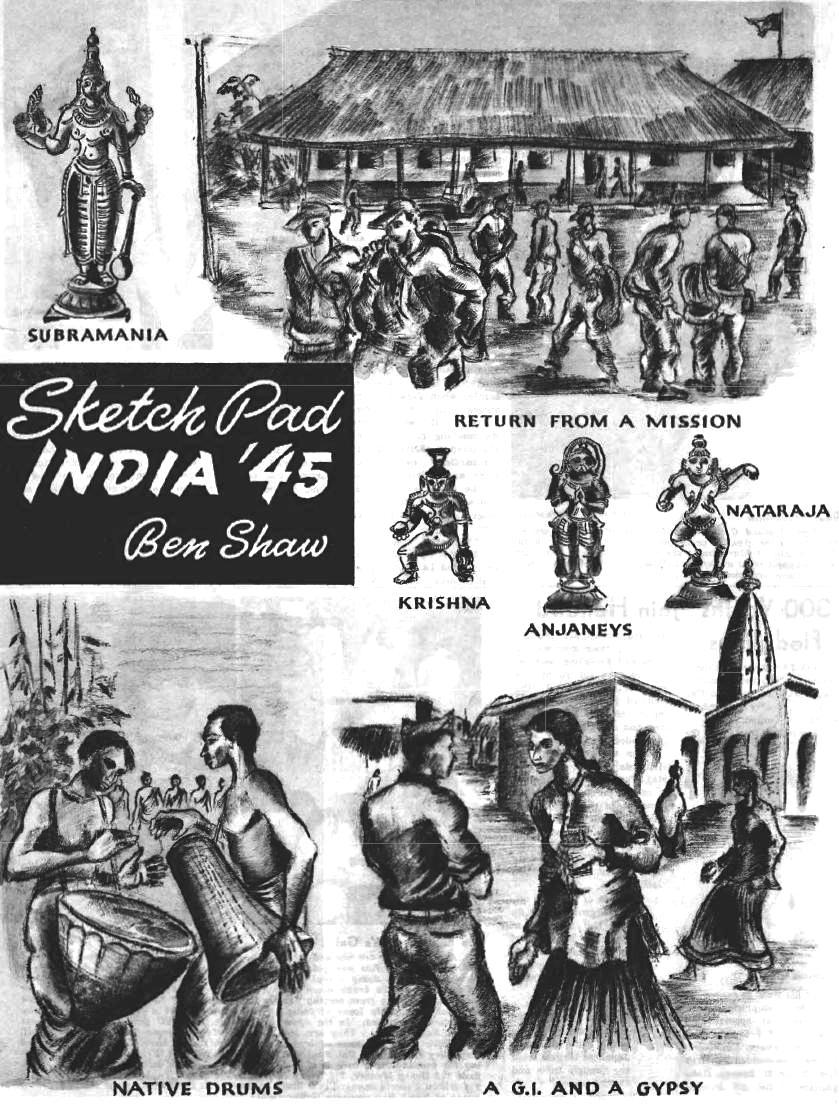
SHARKS ATTACK B-29 CREWMEN
Three Men Lost After Crew 'Chutes From Burning Plane
APO 631 (Chakulia, India) - Cool waters of Martaban bay were nothing to the fire-scorched flesh of Lt. Mills Bales, co-pilot of a B-29 photo-reconnaissance Superfortress.
As he bobbled with the waves, futilely searching for the other 11 members of the crew, he relived the "flying hell" from which he had escaped a few minutes before. The future held little more promise . . . closest land, Jap occupied, was 80 miles away . . . home base was 1100 miles distant, 600 over enemy waters . . . the Bay was shark-infested.
"It was all like a dream - a nightmare."
Piloted by Capt. James E. Lyons who, with Lt. Frank Thorpe, flight engineer, is still confined to a
|
"All was well, and the 'milk run' was about over." A Jap fighter was sighted in the distance - bearing in. The B-29 gunners blazed the sky with tracers, but the fighter kept coming in, making six passes in all.
"Evidently our guns were not working properly," Lt. bales reported later, "as the fighter was not shot down. Ordinarily we would have gotten him before he ever started his pass, but no such luck."
"On his second pass, the sonabitch really loaded us. A 20mm shell exploded in the cockpit and severed our hydraulic lines and ignited them all at the same time. The cockpit was a mass of flames immediately."
Soon afterward - the fighter kept riddling the huge bomber - the B-29 was crippled almost beyond the flying state. Everything seemed to happen all at once. An engine went out, the automatic pilot had been shot up, most of the Superfort was ablaze, and the bomber was in a "very steep spiral."
In three minutes, the plane had dropped from 24,000 to 12,000 feet. Lt. Bales righted the B-29, then made a quick check of the crew. At the same time, another B-29 recon ship had come to the rescue and chased off the fighter.
"The Engineer had several spots on his hands with no skin; the Captain had worse burns on his hands and face and was in a bad state of shock, his eyes being very glassy; the Bombardier - a human torch immediately after the 20mm shell exploded - was in a much worse state as he had had all his clothes burned off so that he was a very terrible sight . . . I didn't have any skin on my nose, and my right hand was a big blister."
All efforts were made to get the plane home. The cockpit fire was extinguished by the captain and engineer, the bomb bay tanks were salvoed - with much difficulty - and the plane was completely stripped by the enlisted men in
|
"It would be almost certain death to our boys in the back if we ditched, besides the possibility of the plane blowing up on contact with the water."
Bailing out presented its problems too. rescue chances were slim, the Bombardier wouldn't have a chance, and many of the others needed immediate medical attention. Japanese occupied land was but 80 miles distant, but that was out of the question.
The Bombardier heard me mention the possibility of killing the crew in the aft to try to ditch so we'd have him where we could take care of him. He turned to us and looking up, he said: 'Listen, if you're going to risk your lives to try to save me, let's get the hell out of here.'"
After the rest of the crew had bailed out, Lt. Bales searched the ship, then "hit the silk." Less than one minute later, the Superfortress exploded.
The other B-29 circled the hapless crew several times, tossed over a life raft, then had to leave for home because of gasoline shortage.
"I could never explain my feelings when that B-29 went out of sight over the horizon."
After he had been in the water about two hours, Lt. Bales noticed some "10 or 15 tell-tale fins in the water." Sharls. They glided toward him at a tremendous rate of speed. They attacked.
"The first shark came in and went between my legs. Hw hit me so hard it nearly up-ended me and my legs flew apart . . . It wasn't long till he was back again. I had taken off my shoes as soon as I hit the water, but kept my socks on. The second time he snapped my left foot and left a set of teeth marks on my foot . . . He came by once more on the surface about four inches from my right elbow. I hit him a swat and that was the last I saw of him.
"The rest stalked me for several hours, roaming about 50 feet away. I have a very great dread of
|
After some 20 hours in the water, with a leaking 'mae west,' Lt. Bakes was surprised to see a British PBY taxi near him. He was the first "fished" from the water. The PBY also picked up Capt. Lyons, Lt. Thorpe, T/Sgt. Louis Sandrick, left gunner, and Cpl. Anthony Peleckis, and flew them to Calcutta, where they were hospitalized.
Some eight hours after the initial rescue, the three crewmen who had swum to the life raft, Lt. Vernon W. Lester, radioman specialist, Lt. Nathan Teplick, navigator, and Sgt. Joseph Dimock, radio operator, were picked up by a British submarine, and later flown to Calcutta in a PBY. T/Sgt. John Topolski, over whose head the initial PBY had flown several hours earlier, also was picked up by the submarine.

|
All of their stories were similar to the one told by Lt. Bales. They saw sharks - Capt. Lyons was nipped a few times by one - heard Japanese barges crawling up and down the water and lived a regular "life of hell" until rescued.
Three crew members haven't been found, although all of their 'chutes were seen to open when they bailed out. They are Lt. William Kintis, bombardier, Sgt. John Carney, tail gunner, and Pfc. James Moffit, center gunner.

|
 Any pool of water serves as a "washing machine," and Indians launder their clothing by beating it
against rocks.
Any pool of water serves as a "washing machine," and Indians launder their clothing by beating it
against rocks.
|
 Fortune tellers are everywhere. This one uses a trained monkey for delving into the mystic world.
Fortune tellers are everywhere. This one uses a trained monkey for delving into the mystic world.
|
 Bullock carts provide the main form of transportation, are used for hauling everything from fragile
pottery to heavy timbers.
Bullock carts provide the main form of transportation, are used for hauling everything from fragile
pottery to heavy timbers.
|
 Temples receive the most attention from American soldiers, who spend much time in studying the
numerous India religions.
Temples receive the most attention from American soldiers, who spend much time in studying the
numerous India religions.
|
 One of the most symbolic photos of the XX Bomber Command and India is this one of a line of coolies
passing in front of a Superfortress. The coolies helped build miles and miles of runways for the Command.
One of the most symbolic photos of the XX Bomber Command and India is this one of a line of coolies
passing in front of a Superfortress. The coolies helped build miles and miles of runways for the Command.
|
 |
 |
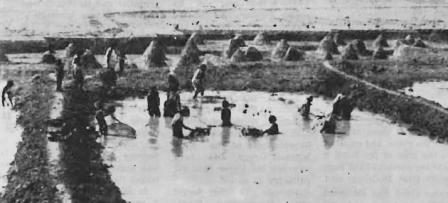 Rice paddy fishing isn't a profitable occupation, but it does provide some food, and bait for river fishing. The Indians, women and men alike, are seining one of the many roadside ponds.
Rice paddy fishing isn't a profitable occupation, but it does provide some food, and bait for river fishing. The Indians, women and men alike, are seining one of the many roadside ponds.
|
 Ferry boat operators do a prosperous business, transporting Indians across the many "restricted
bridge" rivers.
Ferry boat operators do a prosperous business, transporting Indians across the many "restricted
bridge" rivers.
|
 India, more so than any other country in this world, has its very wealthy and extremely poor.
This photo, taken from the porch of a guest house, shows one of the smaller palaces of a maharajah.
India, more so than any other country in this world, has its very wealthy and extremely poor.
This photo, taken from the porch of a guest house, shows one of the smaller palaces of a maharajah.
|
 Cows are sacred to most of the India populace, are free to roam everywhere - whether it be through
the business district of a large city, or the grounds of a common villager. Dung is plastered on walls of buildings,
left to dry, and then used as fuel.
Cows are sacred to most of the India populace, are free to roam everywhere - whether it be through
the business district of a large city, or the grounds of a common villager. Dung is plastered on walls of buildings,
left to dry, and then used as fuel.
|
 The primitive inhabitants of rural India hardly exist, living in slit-bamboo shelters and eating
only what they can harvest from the land. Their way of life is almost unbelievable.
The primitive inhabitants of rural India hardly exist, living in slit-bamboo shelters and eating
only what they can harvest from the land. Their way of life is almost unbelievable.
|
|
Pilots Lose Props In Mid-Air
APO 631 (Chakulia, India) - It isn't uncommon for Superfortresses to fly long distances and safely land on three - or even two - engines. One case is on record where a XX Bomber Command bomber landed without any functioning engines.
To bring a B-29 home sans propellers is different; recently two from this base lost propellers in mid-air, but proceeded safely to another base.
Capt. Carter McGregor, pilot of "Eddie Allen." was the first to lose a prop. While flying a photo reconnaissance mission to Singapore, his Superfort was jumped by six Jap fighters. The enemy made two striking hits, putting holes in the oil and gasoline tanks of the No. 1 engine.
"The propeller wouldn't feather," Capt. McGregor said, "and it windmilled for six and one-half hours. It made a terrific drag (equal to a flat disc with the same circumference) on the plane and had us all "sweating."
If the propeller, which suddenly shot about 100 feet above the plane, had smashed into the nose of the B-29, it would have wrecked the huge bomber, Capt. McGregor said.
"Our speed was increased 30 miles an hour and we landed at another field."
Nine days later, Capt. McGregor ran into "too damn much" enemy fire and his plane sustained major damage.
While plastering bombs on the Empire Docks at Singapore, Capt. Charles Taylor's B-29 was hit by enemy gunfire. An inboard engine was knocked out and wouldn't feather. About six hours from the target, the propeller whirled off. Out of gasoline, he was forced to land at another base.
Another B-29 from this base is known to have lost a propeller mid-air, but it was lost over enemy territory.
 Jap Decoy Didn't Work
Jap Decoy Didn't WorkIt's the natural thing for Superfortress crews to help other members of their group in distress, but they don't easily fall prey to Jap trickery. The enemy painted a decoy B-29 with 300-foot wingspread, so scaled that it appears to be flying at several thousand feet. From a great altitude, the decoy gives the illusion of a B-29 in flight with flames streaming from its port inboard engine. The Japs figured other planes would be drawn down to investigate and become targets for heavy concentration of flak. None did. |
 Clothed In Money
Clothed In MoneyWith acres of other Superfortresses in the background, the 1,000th B-29 to be produced at the Wichita Division plants of Boeing Airplane Company is ready to move into a theater of operation. The Superfortress bears on its aluminum skin approximately $10,000, spontaneous contribution by Boeing-Wichita employees to the Infantile Paralysis Foundation. |
Superfort Pilot Awarded Silver Star for Gallantry in Action
A XX BOMBER COMMAND BASE, INDIA - Lt. Edward L. Warner of Springfield, Mo., pilot of a B-29 Superfortress of the "Billy Mitchell Group," has been awarded the Silver Star for gallantry in action.
Enroute to the target over Jap-occupied Singapore, Warner's 1 and 2 engines both developed bad oil leaks. Despite this handicap, he elected to continue on course and dropped his bombs on the primary target, even though the smoke pouring from the 2 engine was making him a deadly target for enemy fighters.
In addition to losing the two engines, on the journey home Warner ran low on gas and was forced to
 land at an emergency field to refuel. Since there were no adequate facilities at this field to make the proper
repairs, and knowing that his plane was needed for an immediate future mission, Warner took off at night after refueling and returned to his home base.
land at an emergency field to refuel. Since there were no adequate facilities at this field to make the proper
repairs, and knowing that his plane was needed for an immediate future mission, Warner took off at night after refueling and returned to his home base.
Warner, a veteran of 18 Superfort missions, also holds the Distinguished Flying Cross and Air Medal with two Oak Leaf Clusters.
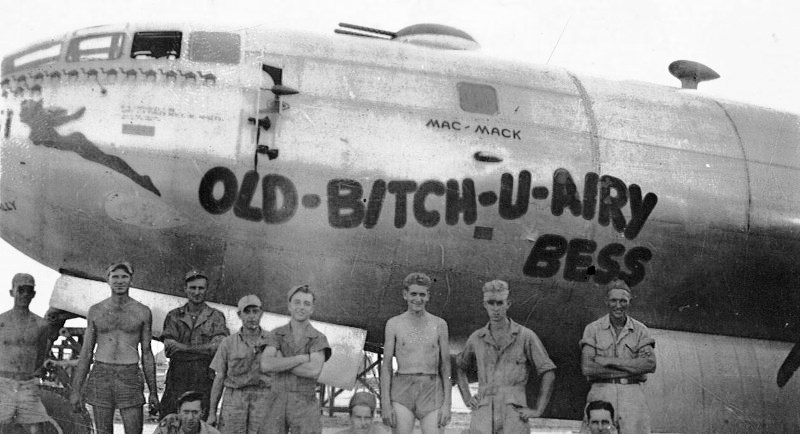 Flight crew poses in front of their plane, which recently flew with
LIFE
photographer in mission over Burma.
Flight crew poses in front of their plane, which recently flew with
LIFE
photographer in mission over Burma.
|
 Tail gunner at his position.
Tail gunner at his position.
|
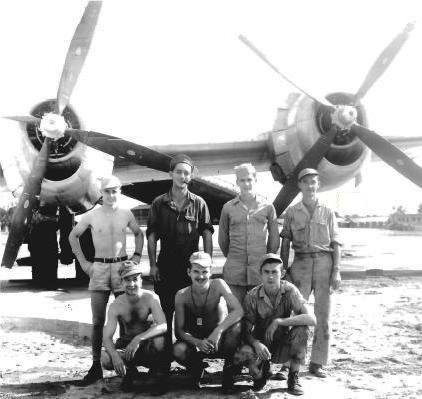 S/Sgt. Edwin O. Duty (back row, right), Crew Chief and other members of the ground crew.
S/Sgt. Edwin O. Duty (back row, right), Crew Chief and other members of the ground crew.
|
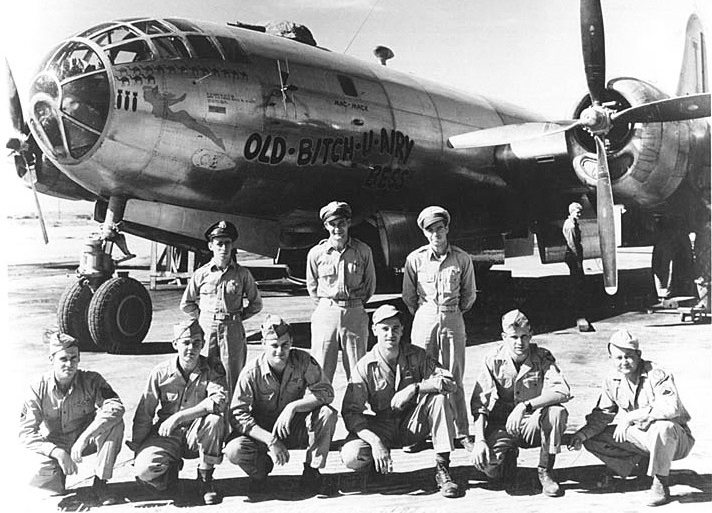 Another crew of "OLD•BITCH•U•AIRY BESS" - Front Row (L to R): Irving Lash (Crew Chief - Flight Engineer), Milt Johnson (Right Gunner), Wendell Sheffield (Top Senior Gunner), Eugene Szatlocky (Radar), Rex Walker (Left Gunner), John (Doaksie) Griffin (Tail Gunner).
Back Row (L to R): John Mack (Navigator), William Wisener (Bombadier), Bruce Whitfield (Pilot).
Another crew of "OLD•BITCH•U•AIRY BESS" - Front Row (L to R): Irving Lash (Crew Chief - Flight Engineer), Milt Johnson (Right Gunner), Wendell Sheffield (Top Senior Gunner), Eugene Szatlocky (Radar), Rex Walker (Left Gunner), John (Doaksie) Griffin (Tail Gunner).
Back Row (L to R): John Mack (Navigator), William Wisener (Bombadier), Bruce Whitfield (Pilot).
|
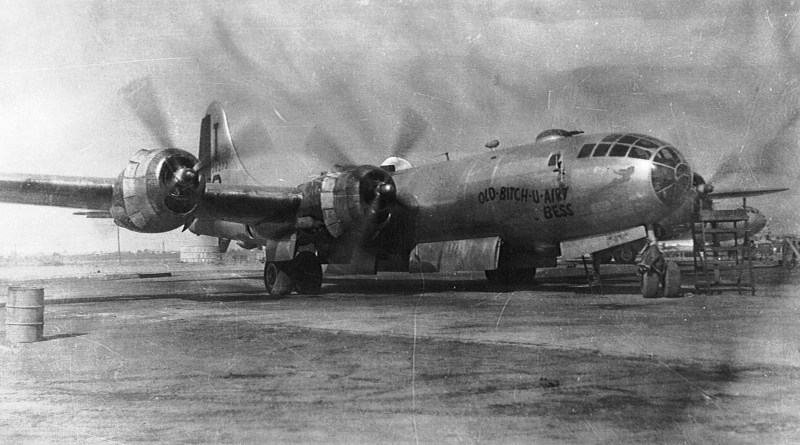 "Old-Bitch-U-Airy Bess" on the hard deck of the flight line being checked and serviced, engines running.
"Old-Bitch-U-Airy Bess" on the hard deck of the flight line being checked and serviced, engines running.
|
|
A XX BOMBER COMMAND BASE, INDIA - Award of the Silver Star for gallantry in action has been made to Capt. John E. Siler of Lake Worth, Fla., pilot of the B-29 Superfortress, "Princess Eileen."
After "bombs away" over Omura, Japan, Capt. Siler noticed another B-29 in distress as the result of a furious gun battle with enemy fighters. Despite a serious oil leak which eventually necessitated feathering an engine, Siler voluntarily left his position in the formation to fly protective cover for the crippled aircraft.
Although losing an engine after reaching the China coast, Siler continued to escort the damaged plane, and after his gunners routed a fighter attack over the interior of China, both planes managed to land safely at a friendly field.
|
A XX BOMBER COMMAND BASE, INDIA - How a B-29 Superfortress of the XX Bomber Command photographed the coast of Luzon before Gen. Douglas MacArthur's invasion of that island in the Philippines has been disclosed in a citation for the entire crew.
|
The Distinguished Flying cross has been awarded Capt. Peter Boyko, Rochester, N.Y. and Sgt. Edward George, Chicago, Ill., the two aerial photographers who crouched determinedly behind their cameras and shot pictures as the giant bomber circled Lingayen Gulf unescorted for almost an hour.
The reconnaissance mission, flown from a China base of the XX Bomber Command, covered some 3200 miles, most of which was over enemy territory. The citation stated, in part, "the excellent photographs brought back of enemy targets greatly aided and abetted the prosecution of the war."
Three enemy fighters were encountered high over the target, but after performing various acrobatics, none elected to close on the Superfort and they streaked off without exchange of gunfire.
Pilot of the B-29 was Col. William P. Brett, Falls Church, Va., who was awarded the Oak Leaf Cluster to the Distinguished Flying Cross.
Other members of the crew who also were given the Oak Leaf Cluster to the DFC were: Maj. Arnold Wilson, LaSalle, Ill; Lt. Edward Case, Blue Springs, Neb.; Lt. Vernon Wilcox, Santa Monica, Calif.; S/Sgt. Stanley Ellis, Fullerton, Calif.; T/Sgt. William Jokela, Eureka, Calif.; M/Sgt. Felix Czerw, Avoca, Pa.; S/Sgt. James B. Cumming, New Rochelle, N.Y., and S/Sgt. John Desjardines, Dover, N.H.
S/Sgt. Austin . . .
Stops Detonation of Bombs, Saves Crew Members, B-29
APO 215 (Charra and Dudhkundi) - Only 35 seconds - the time for a bomb to detonate - separated life and death for 11 crew members of a Superfortress.
Time was precious and S/Sgt. John D. Austin of Shreveport, La., didn't waster it. He went into immediate action, stopped the detonation spinners of three armed bombs, saving the lives of the crew and a costly bomber.
The B-29 gunner recently was awarded the Silver Star for his gallantry.
Over the target at Hankow, in Jap-occupied China, three big incendiary bombs jammed in the rear bomb bay of the plane in which Austin was flying. The emergency system wouldn't dispose of the bombs.
Without oxygen at 20,000 feet altitude, Jap fighters attacking from below, Austin volunteered to crawl into the bomb bay. He was horrified. The strong wind sweeping through the bomb bay had started the spinners whirling on three armed bombs. Austin knew the bombs would detonate within 35 seconds,

|
He quickly lunged for the bombs and clamped his hands tightly over the spinners; then managed to shove a cocking lever in the bomb bay which released all three bombs simultaneously. Passing out, obviously from lack of oxygen, Austin was dragged from the bomb bay by fellow crewmen and given first aid.
Awarded DFC Posthumously
A XX BOMBER COMMAND BASE, INDIA - Posthumous award of the Distinguished Service Cross has been made to Capt. John A. Dunn of Hutchinson, Kan., pilot of a B-29.
The award was made for extraordinary heroism and gallantry in action while participating in a mission against Omura, Japan.
Coming off the bombing run, Dunn's plane was seriously damaged by enemy fighters and it became apparent that it could not reach its home base. But rather than risk the chance of survival of the crew members by ditching in the choppy, enemy-patrolled Yellow Sea, Dunn elected to remain airborne in an attempt to reach a friendly airstrip in China.
Only by remarkable flying skill and courage was he able to maneuver the crippled plane to this friendly airstrip. But forced to land downwind on an unfamiliar field, he crashed into a group of buildings on the side of the runway. Dunn and three other members of the crew died in the accident, but seven escaped uninjured.

|

|
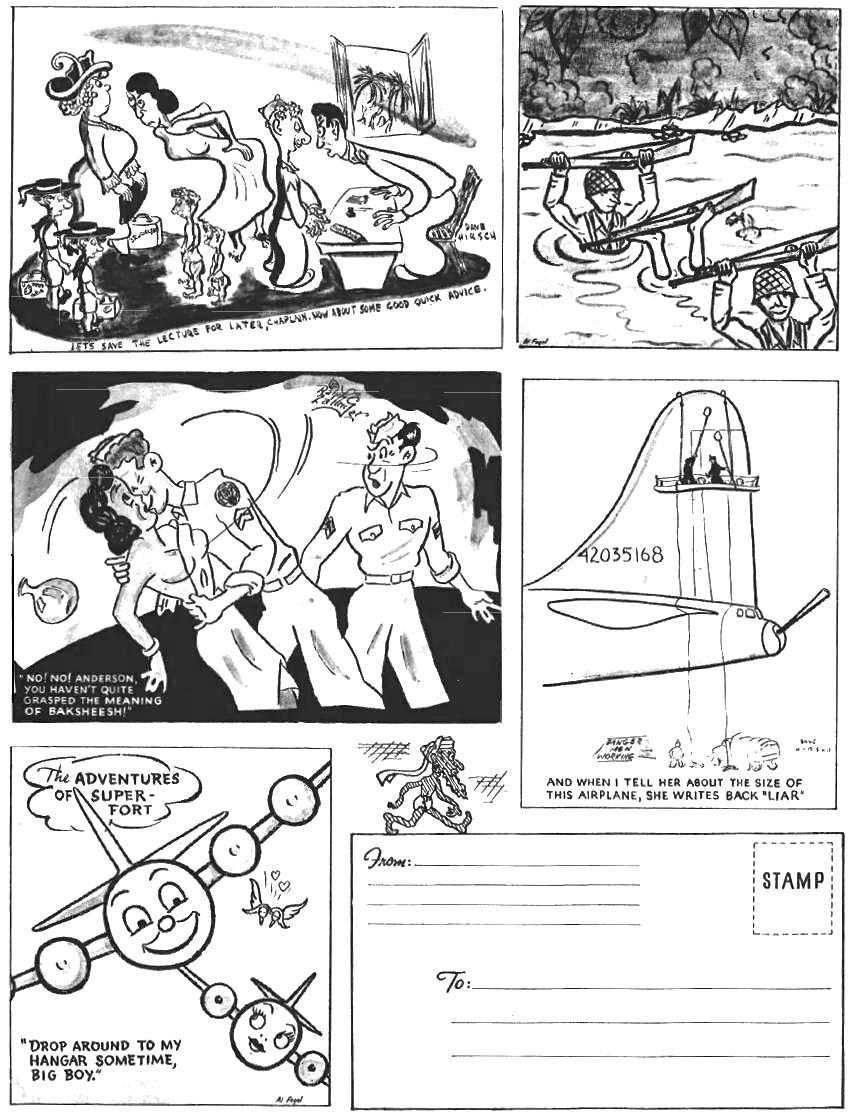
SUPER-FORT is published from news and pictures supplied by staff members, base correspondents, OWI and Army News Service, and Camp Newspaper Service. Reproduction of CNS credited matter prohibited without permission of Camp News Service, 205 E. 42nd St. NYC 7. Published semi-monthly by the Information-Education branch of Personnel Section and Special Service Section of the XX Bomber Command. (Articles and photos are solicited and should be sent to SUPER-FORT, XX Bomber Command, APO 493, I-B Theatre.)

NEWS PUBLICATION OF THE XX BOMBER COMMAND
|
"Not just the best trained soldier in the world, not just the best equipped
soldier in the world, but the BEST INFORMED soldier in the world." |
Vol. 1 No. 7 • 13 April 1945
Original issue of SUPER-FORT shared by Earl and Diana (Duty) Ingram
Additional photo provided by Gary Lash
Photos of "Old-Bitch-U-Airy Bess" did not appear in the original issue.
Copyright © 2007 Carl Warren Weidenburner
B-29 SUPERFORTS BOMB JAPANESE MAINLAND
TOP OF PAGE PRINT THIS PAGE ABOUT THIS PAGE
E-MAIL YOUR COMMENTS SUPER-FORT BASE
 Silently Await the Word
Silently Await the Word

 Enemy Damage
Enemy Damage Improvises Metal Cutter
Improvises Metal Cutter Presents DSC
Presents DSC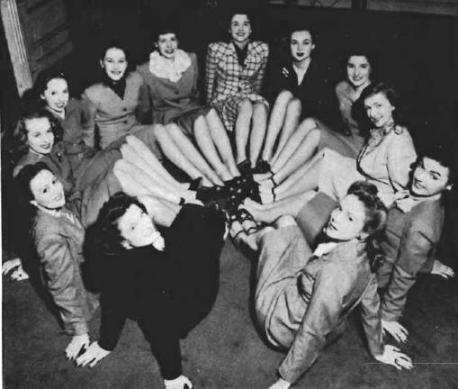 A Dozen Beauties
A Dozen Beauties Commended
Commended Shows Shark Bites
Shows Shark Bites Fished From Sea
Fished From Sea Rescued by Sub
Rescued by Sub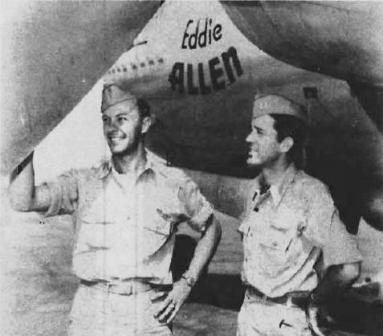 Lost Props Mid-Air
Lost Props Mid-Air

 Receive DFC
Receive DFC